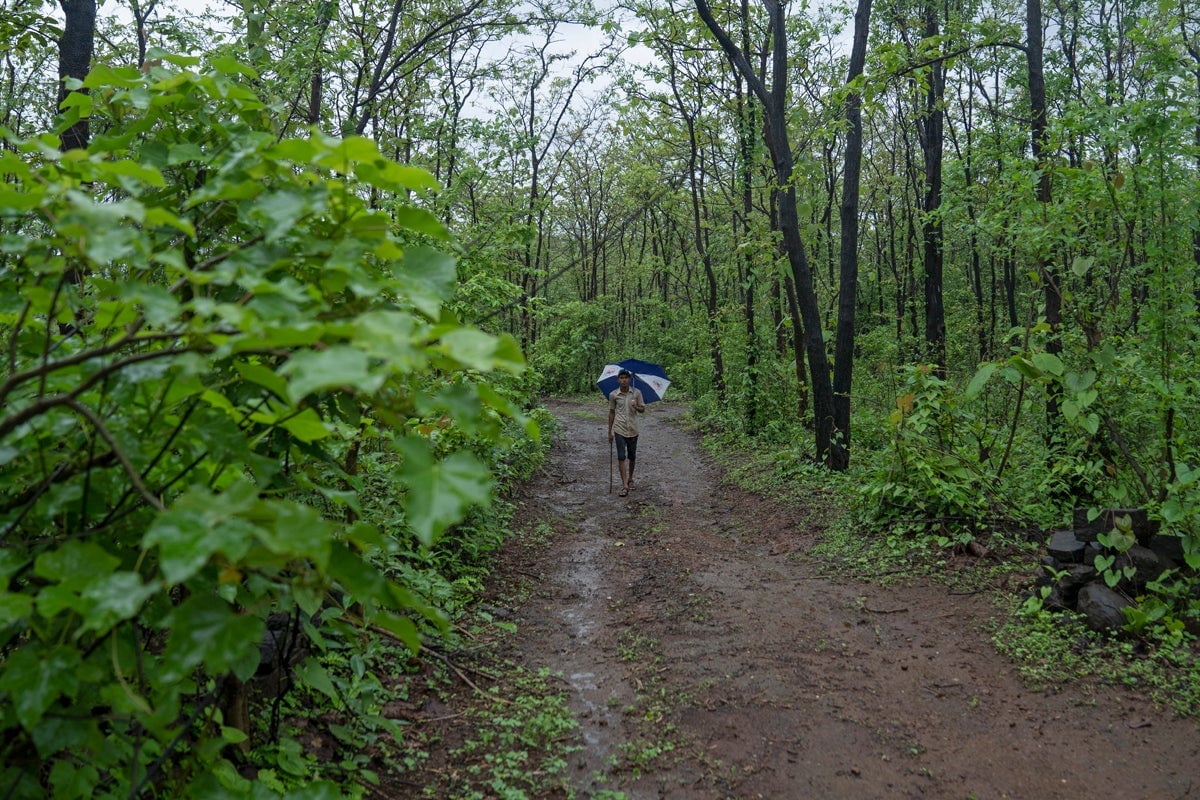India’s missing a clear forest policy and its jungle dwellers are the worst off
How do you define a “forest?” What are the rules regarding inviolate forests? And when will India get its new national forest policy? Many questions loom even as India pursues its goal of having 33% of its land under forest cover. While the latest data reveals increasing forest cover in the country, will the uptick continue without a comprehensive and focused forest policy?


How do you define a “forest?” What are the rules regarding inviolate forests? And when will India get its new national forest policy? Many questions loom even as India pursues its goal of having 33% of its land under forest cover. While the latest data reveals increasing forest cover in the country, will the uptick continue without a comprehensive and focused forest policy?
India’s forests are currently governed by the National Forest Policy (NFP) 1988, an update to which has been in the offing for nearly four years now. Key policies regarding forests and forest management are either missing, delayed or left open-ended as of date. For example, at present, there is no clear definition of “forest” that is accepted nationally and states are left to determine their definition of forests. There is no central policy on inviolate forest (forests that are to be left untouched). In terms of forest management, there are regular attempts to involve the private sector. But this has experts concerned about the tribal community and the forest dwellers who could be negatively impacted.
One of the constant criticisms of the central government over the years is its speedy pace of giving clearances to projects requiring forest land diversion while it drags its feet on recognising the rights of tribal people and forest dwellers over forests.
The central government had attempted to make progress on the forest rights front in 2019, when it unveiled a zero draft of an amendment to the Indian Forest Act (IFA) 1927. The draft came under heavy criticism from civil society on the grounds that it gives more power to the forest department authorities, including giving them the power to shoot people, and undermines the role of forest dwellers. The zero draft was withdrawn by the government in November 2019.
While withdrawing the zero draft, Indian government’s environment minister Prakash Javadekar had stated that the central government for the past five years has “always worked in the interests of tribals and forest dwellers. We are completely withdrawing the draft amendment to the Indian Forests Act to remove any misgivings, the tribal rights will be protected fully and they will continue to be an important stakeholder in forest development,” Javadekar had said.
“It is very clear that the intention of the government is to do nothing for the forest and only ensure that maximum power stays in the hands of forest officials. Anything or any discussion about the rights of people living in forests or a clear policy on forests is brushed aside. The idea is to have an autocratic regime run by bureaucrats,” Shankar Gopalakrishnan, secretary of the Campaign for Survival and Dignity, a national platform of forest dwellers groups, told us.
“Any attempt to make forest management more transparent or democratic is treated as anti-development and anti-national. It is clear what the forest staff is trying to achieve. The whole policy is in limbo,” said Gopalakrishnan.

New national forest policy yet to see the light of the day
The first NFP in independent India came into effect in 1952. Thereafter, in 1988, a new version of the NFP came into being. The latest version has been in the offing for nearly four years now but a final version is yet to be made public.
Nearly three and a half years ago, in June 2016, the environment ministry unveiled a draft NFP, but when it came under fire for not being enough to protect the then-existing forest regulations, the environment ministry backtracked, calling it just a “study”. Subsequently, in 2018, the central government officially unveiled the draft of the NFP. The draft was then revised in 2019 as well, but since then there has been no news about the final version of the NFP.
A new forest policy is a significant and much-required document because it provides an overarching framework and direction for the management and regulation of forests in the country. It is expected to take into account the legal changes that deal with forests, climate change, pollution and other pressing requirements.
In the absence of an updated national forest policy, environmentalists believe that everything is being run on an ad-hoc basis.

Babul Supriyo, the minister of state in the Ministry of Environment, Forest and Climate Change (MoEFCC), in July 2019, had told parliament “no time has been set to the adoption of a new national forest policy” and as of now “the existing NFP 1988 is in operation.” He had stated that the MoEFCC had prepared the draft NFP 2018 as a revision to the 1988 version.
“After an exhaustive and wide consultation process with all major stakeholders and incorporating their feedback, the draft National Forest Policy, 2019 has been prepared. The basic thrust of the draft National Forest Policy, 2019 is conservation, protection and management of forests along with safeguarding the interest of tribals and forest-dependent people,” Supriyo had said.
However, experts disagree with the government’s assertion that the thrust of the new draft is towards safeguarding the interests of forest dwellers and tribal people.
Sharachchandra Lele, a distinguished fellow at the Centre for Environment and Development, Ashoka Trust for Research in Ecology and the Environment (ATREE), explained that “one of the main problems is that the imminent forest policy sets the wrong priorities for forests, viz., carbon storage and water management, unlike the 1988 forest policy which had environment balance and livelihood at the centre.”
“The new policy is ignoring the continued dependence of communities on forests for their livelihood and overemphasises carbon benefits, which are small and come at significant costs to local people and biodiversity. Another problem is that we are putting too much emphasis on afforestation for water management. Forests do play a role in hydrological regulation, but the drying up of rivers and the larger problem of water (scarcity) has nothing to do with forests. It is more to do with dams, over-exploitation of groundwater, pollution, and poor regulation. Large-scale afforestation cannot solve the problem of less water in rivers,” Lele said.
Lele stressed that given that forests provide multiple but somewhat competing benefits and forest land is also sought for non-forest activities, what is required is a focus on forest governance, on the mechanisms for resolving these trade-offs, and ensuring sustainable management.
Environmental lawyer Ritwick Dutta said that the NFP 1988 is a “forgotten document.”
“Though the supreme court in the Lafarge case made it clear that every diversion of forest land for the non-forest purposes must be in accordance with the NFP 1988, neither the government of India or even the supreme court has taken the judgement or the policy seriously. The NFP 1988 has several problems but the (new) draft policy is even more problematic,” Dutta told us. “Merely by using words such as ‘climate change,’ ‘carbon sink,’ and the ‘rights of forest dwellers,’ a policy does not become progressive. It can be a hollow document despite using all the jargon.”

No country for tribal communities and forest dwellers
Over the past few years, one of the major concerns of environmentalists has been the poor implementation of the Forest Rights Act 2006, which protects the rights of tribal communities and forest dwellers over the forest resources.
Apart from the flip-flop over the amendment to IFA 1927 in 2019, following a supreme court order, the issue of evicting tribal people and forest dwellers from forests after the rejection of their claims, gained traction. The order by the apex court in February 2019 came just a couple of months before the parliamentary elections in April-May 2019. The order could have impacted nearly two million tribal families—about 8-10 million people—across the country. But after opposition parties and civil society groups cornered the government, the eviction of tribal people was stayed by the court.
Experts point out that this is not the first time that attempts have been made to undermine the rights of tribal communities.
ATREE’s Sharachchandra Lele emphasised that “the last forest policy made a beginning by mentioning people’s participation in restoring degraded forests. But that was 31 years ago. Since then, so much has happened including JFM (joint forest management) and the FRA 2006.”
“Now is the time to integrate all those lessons and focus on better management and governance of forests while resolving conflicts between different stakeholders. We need to remember that we are still a forest-dependent population, especially the ones who are most marginalised and poverty-stricken. That is where we really need to focus our attention,” said Lele.
“There is no commitment (by the government) to socially just and sustainable forest conservation. We need to understand that local communities (tribal people and other forest dwellers) are not just stakeholders but the actual rights-holders. The narrative that the entire forest belongs to the nation and the forest department is nothing but a colonial concept. This is wrong. The role of the state in forests should be limited to regulating it and not managing it,” he said.

Environmentalist Madhu Sarin said that the “forest bureaucracy continues to ignore the millions of people dependent on forests who now have statutory forest rights.”
“Instead, the principal thrust is on increasing privatisation, industrialisation and the diversion of forests resources for commercial exploitation,” Sarin told us.
Several government reports over the past five years have pushed for the involvement of the private sector in managing the forests. In 2018, an expert committee report had recommended leasing of wasteland to the corporate sector for re-greening. Shankar Gopalakrishnan said “the constant attempt to involve the private sector is part of the efforts to make forests an asset for forest officials and private companies. In the process, tribal communities and forest dwellers are treated as the enemy.”
The latest India State of Forest Report 2019 which was released by the MoEFCC in 2019 even emphasised that even though India’s overall forest and tree cover increase in 2019 when compared to 2017, the forests under the category “recorded forest area” (land notified as forest by the government) in tribal districts, which are home to about 60 percent of India’s forests, is decreasing.
At present, nearly 25% of India’s total geographical forest area is under forest and tree cover.
The perils of compensatory afforestation loom large
Attempts towards the dilution of forest regulations have been made by various governments. However, post-2014, with “ease of business” at the forefront of the government’s action plan, dilution of forest laws gained pace as the prime minister promised to speed up clearances for industries looking at projects in forest land.
A 2014 report by a committee led by former cabinet secretary T.S.R. Subramanian suggested an overhaul of environment and forest laws. Though the report was shelved, many of the changes recommended have been separately brought in by the ministry by way of executive orders.
ATREE’s Lele emphasised that the central government has “refused to identify no-go areas and beyond the core of protected areas, everything is available for diversion.”
“According to one of our studies, which is expected to be published soon, out of the 128 cases (involving forest land of 100 hectares or more) that the MoEFCC’s forest advisory committee considered for diversion since 2009, 120 cases received final or in-principle approval for forest land diversion,” said Lele.
“We examined the forest clearance process since 2009 to see whether the incorporation of FRA certification had made a difference. But the success witnessed in the Niyamgiri case has never been repeated and the authority of gram sabhas is repeatedly violated in cases one after another,” he added.
In India, the diversion of forest land for non-forestry use is governed under the Forest Conservation Act 1980 under which any organisation seeking diversion of forest area needs to support “compensatory afforestation” where trees are planted (either directly or via the forest department) to compensate for the lost forest.
On this, Lele alleged that the whole system of compensatory afforestation is “fundamentally flawed as one cannot compensate for natural forest by plantations, and even compensatory afforestation is flawed as one cannot do that on common community land—something that is happening right now.”
In December 2019, the forest advisory committee of the MoEFCC recommended a scheme in principle under which compensatory afforestation can be achieved by buying plantations raised in advance. These plantations can be raised by private or public-private firms once they are accredited by the ministry. A news report by the Hindustan Times cautioned that such a scheme would lead to the commoditisation of precious forest land.
Meanwhile, even as the efforts are being made to increase the forest cover, on January 8, 2019, the Union Cabinet decided to bring Mineral Laws (Amendment) Ordinance 2020 which will come into force after the President of India’s assent to ensure greater production of coal.
The Union Minister of Mines Prahlad Joshi, explained that this Ordinance will further the ‘ease of doing business’ and “democratise Indian coal sector.”
“Now it is open for anyone willing to invest & help ramp up coal production and drastically reduce the coal imports over time,” tweeted Joshi while explaining that now partially/regionally explored coal blocks can also be put for auction which will help in increasing the available inventory of coal.
The minister explained that of the 1.4 billion tonnes coal demand likely by 2023-24, Coal India Limited has to produce one billion tonnes while the private sector will help in bridging the gap.
But ramping up coal production will directly or indirectly mean opening up of more of India’s forests for mining.
This post first appeared on Mongabay-India. We welcome your comments at [email protected].